
The swamp eels are a family (Synbranchidae) of freshwater eel-like fishes of the tropics and subtropics. Most species are able to breathe air and typically live in marshes, ponds and damp places, sometimes burying themselves in the mud if the water source dries up. They have various adaptations to suit this lifestyle; they are long and slender, they lack pectoral and pelvic fins, and their dorsal and anal fins are vestigial, making them limbless vertebrates. They lack scales and a swimbladder, and their gills open on the throat in a slit or pore. Oxygen can be absorbed through the lining of the mouth and pharynx, which is rich in blood vessels and acts as a "lung".

The ribbon eel, also known as the leaf-nosed moray eel or bernis eel, is a species of moray eel, the only member of the genus Rhinomuraena. The ribbon eel is found in sand burrows and reefs in the Indo-Pacific Ocean. Although generally placed in the moray eel family Muraenidae, it has several distinctive features leading some to place it in its own family, Rhinomuraenidae.

Cutthroat eels are a family, Synaphobranchidae, of eels, the only members of the suborder Synaphobranchoidei. They are found worldwide in temperate and tropical seas.

The New Zealand longfin eel, also known as ōrea, is a species of freshwater eel that is endemic to New Zealand. It is the largest freshwater eel in New Zealand and the only endemic species – the other eels found in New Zealand are the native shortfin eel, also found in Australia, and the naturally introduced Australian longfin eel. Longfin eels are long-lived, migrating to the Pacific Ocean near Tonga to breed at the end of their lives. They are good climbers as juveniles and so are found in streams and lakes a long way inland. An important traditional food source for Māori, who name them ōrea, longfin eel numbers are declining and they are classified as endangered, but over one hundred tonnes are still commercially fished each year.

The mottled eel, also known as the African mottled eel, the Indian longfin eel, the Indian mottled eel, the long-finned eel or the river eel, is a demersal, catadromous eel in the family Anguillidae. It was described by John McClelland in 1844. It is a tropical, freshwater eel which is known from East Africa, Bangladesh, Andaman Islands, Mozambique, Malawi, Sri Lanka, Sumatra, and Indonesia and recently from Madagascar. The eels spend most of their lives in freshwater at a depth range of 3–10 metres, but migrate to the Indian Ocean to breed. Males can reach a maximum total length of 121 centimetres and a maximum weight of 7,000 grams. The eels feed primarily off of benthic crustaceans, mollusks, finfish and worms.
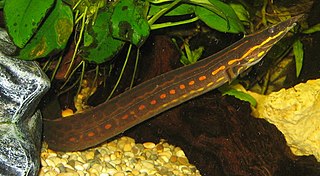
The fire eel is a relatively large species of spiny eel. This omnivorous freshwater fish is native to Southeast Asia but is also found in the aquarium trade. Although it has declined locally due to overfishing, it remains common overall.
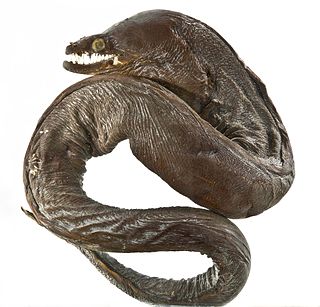
The viper moray is a species of saltwater eel, the only member of the genus Enchelynassa of the family Muraenidae. It is found in the Indo-Pacific oceans. It can grow up to 250 cm.
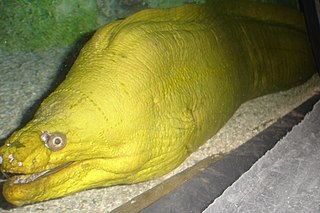
The green moray is a moray eel of the family Muraenidae, found in the western Atlantic Ocean from Long Island, New York, Bermuda, and the northern Gulf of Mexico to Brazil, at depths down to 40 metres (130 ft). Its length is up to 2.5 metres (8.2 ft). It is the largest moray species of the tropical Atlantic and one of the largest species of moray eel known. Though it is not considered endangered, the species is particularly under-studied and estimated to be undercounted by up to 400% in single-pass visual surveys.
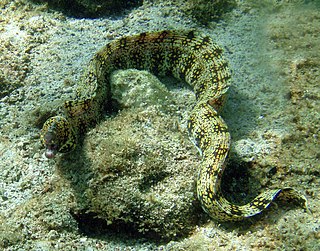
The snowflake moray, also known as the clouded moray among many vernacular names, is a species of marine eel of the family Muraenidae. It has blunt teeth ideal for its diet of crustaceans, a trait it shares with the zebra moray.

Gorgasia preclara, the splendid garden eel or orange-barred garden eel, is a species of marine garden eel.
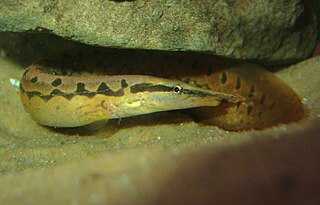
The zig-zag eel, also known as the Baim,tire-track, tire-track spiny- or marbled spiny eel, is a species of freshwater ray-finned fish in the family Mastacembelidae. It is native to the riverine systems of the Indian Subcontinent, Sri Lanka, Malaysia,Thailand, Vietnam, Cambodia, Indonesia, and other parts of South and Southeast Asia. The species was initially described as Macrognathus armature. Other common names for this popular captive species include the leopard spiny eel and white-spotted spiny eel.
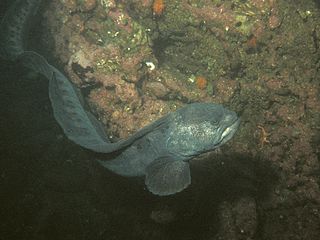
The wolf eel is a species of marine ray-finned fish belonging to the family Anarhichadidae, the wolf fishes. It is found in the North Pacific Ocean. Despite its common name and resemblance, it is not a true eel. It is the only species in the monotypic genus Anarrhichthys.

The blind cave eel is a species of cavefish in the family Synbranchidae. It is the longest cavefish in Australia and one of the only three vertebrates in Australia that is restricted to underground waters, the other being the blind gudgeon and the Barrow cave gudgeon. It is blind, its body is eel-like and elongated, and it has a non-pigmented skin with colours ranging from white to pink.

Eels are ray-finned fish belonging to the order Anguilliformes, which consists of eight suborders, 20 families, 164 genera, and about 1000 species. Eels undergo considerable development from the early larval stage to the eventual adult stage and are usually predators.

Protanguilla palau is a species of eel, the only species in the genus Protanguilla, which is in turn the only genus in its family, Protanguillidae. Its common name is Palauan primitive cave eel. Individuals were found swimming in March 2010 in a deep underwater cave in a fringing reef off the coast of Palau.

Eels are elongated fish, ranging in length from five centimetres (2 in) to four metres (13 ft). Adults range in weight from 30 grams to over 25 kilograms. They possess no pelvic fins, and many species also lack pectoral fins. The dorsal and anal fins are fused with the caudal or tail fin, forming a single ribbon running along much of the length of the animal. Most eels live in the shallow waters of the ocean and burrow into sand, mud, or amongst rocks. A majority of eel species are nocturnal and thus are rarely seen. Sometimes, they are seen living together in holes, or "eel pits". Some species of eels live in deeper water on the continental shelves and over the slopes deep as 4,000 metres (13,000 ft). Only members of the family Anguillidae regularly inhabit fresh water, but they too return to the sea to breed.

Chilara taylori, the spotted cusk-eel, is a species of cusk-eel found along the eastern coast of the Pacific Ocean where it is found at depths down to around 280 metres (920 ft) from Washington, United States to Ecuador. This species grows to a length of 40.4 centimetres (15.9 in) TL. It is the only known member of its genus.
The Indo-Pacific shorttail conger, also known as the short-tail conger, is an eel in the family Colocongridae. It was described by Chan William Lai-Yee in 1967. It is a marine, deep-water dwelling eel which is known from the Indo-Pacific, including southern Mozambique, Natal, South Africa, the South China Sea, and eastern Australia. It dwells at a maximum depth of 810 metres (2,660 ft). Males are known to reach a maximum total length of 51 centimetres (20 in).

The Kaup's arrowtooth eel is an eel in the family Synaphobranchidae. It was described by James Yate Johnson in 1862. It is a marine, deep water-dwelling eel which is known from the Indo-Western Pacific and eastern and western Atlantic Ocean, including the Faroe Islands, Iceland, Cape Verde, the Western Sahara, Nigeria, Namibia, South Africa, Greenland, France, Saint Pierre and Miquelon, the United Kingdom, Ireland, the Philippines, Portugal, Spain, the Bahamas, Brazil, Canada, Cuba, Japan, Australia, Mauritania, Morocco, and Hawaii. It dwells at a depth range of 120 to 4,800 metres, most often between 400 and 2,200 metres, and inhabits the upper abyssal zone on the continental slope. It is intolerant of the temperatures of higher waters. Males can reach a maximum total length of 100 centimetres (39 in).

Ilyophinae, the arrowtooth ells or mustard eels, is a subfamily of marine ray-finned fishes belongiing to the family Synaphobranchidae, the cutthroat eels. Within its family this subfamily shows greatest number of species and the greatest morphological diversity.


















